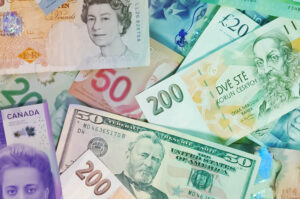
In January 2025, the volume of foreign currency purchases by the Ukrainian population exceeded the volume of its sales by $1 billion 479.8 million, which is 34.1% higher than in January 2024 and 13.6% higher than in December 2024 and is the highest figure since December 2012.
According to the NBU’s website, compared to December, cash currency sales decreased by $157.1 million, while purchases decreased by only $63.4 million to $2 billion 430.9 million, resulting in an increase in the negative balance to $1 billion 290.3 million.
In addition, in January of this year, the sale of non-cash foreign currency decreased by $69.1 million, while its purchase increased by $14 million to $460 million, which led to an increase in the negative balance to $189 million.
At the same time, it is worth noting that in the first half of January, when the hryvnia was weakening, the volume of purchases was higher, and by the end of the month, after the national currency strengthened, the daily negative balance was reduced, and only on the last day of the month and in early February was a significant increase in demand recorded again.
In the legal entities market, after a jump in purchases of foreign currency by bank clients in December to $8.41 billion from $6.22 billion in November, in January, purchases decreased to $5.56 billion, which is only 10% higher than in January last year.
At the same time, the sale of foreign currency by bank clients also fell significantly in January this year, to $3.78 billion from $4.96 billion in December, which is 10% less than in January last year.
As for the volume of transactions between banks, it also decreased compared to December – from a record high of $7.96 billion since the beginning of the war to $6.12 billion. However, this figure is 40.8% better than in January 2024.
As reported, the official hryvnia exchange rate in the first half of January fell from 42.0295 UAH/$1 to a new all-time low of 42.2841 UAH/$1, but in the second half of the month it strengthened to 41.8242 UAH/$1.
The National Bank’s net sale of foreign currency on the interbank market in January decreased to $3.75 billion from a record high of $5.28 billion in December, although this is significantly higher than the January-2024 figure of $2.53 billion.
In total, the volume of foreign currency purchases by the Ukrainian population in 2024 exceeded the volume of its sales by $12.22 billion, which is 2.5 times or $7.43 billion more than in 2023, but thanks to large-scale foreign aid, international reserves increased to $43.8 billion last year.
In 2024, the official hryvnia exchange rate against the US dollar weakened by 10.6%, or UAH 4.02, including 0.9%, or 37 kopecks, in December.

The purchasing power of Europeans in 2024 increased by 3.9% and reached 18.768 thousand euros per capita, according to the research company GfK.
In total, the population of Europe had about 12.9 trillion euros available last year, which could be spent on food, housing and utilities, insurance and pension savings, recreation, mobile communications, and other purchases.
At the same time, disposable income indicators vary significantly among the 42 countries whose data were analyzed by GfK. The highest results were recorded in Liechtenstein, Switzerland, and Luxembourg, while the lowest were in Ukraine, Kosovo, and Belarus. As a result, the difference between the incomes of residents of Liechtenstein and Ukraine exceeds 24 times.
16 out of 42 countries exceeded the regional average, while 26 countries had below-average purchasing power.
“The nominal growth of purchasing power in Europe is 3.9%, which is much more moderate than in the previous two years. However, at the same time, the inflation rate has also slowed down,” NIQ-GfK expert Markus Frank said in a statement.
The top three countries in terms of purchasing power have not changed compared to the previous year: Liechtenstein – 70.18 thousand euros per capita (3.7 times higher than the average value for all countries in the region), Switzerland – 52.566 thousand euros (2.8 times higher), Luxembourg – 41.785 thousand euros (2.2 times higher).
The top ten also includes Iceland, Denmark, Austria, the United Kingdom, Norway, Germany, and the Netherlands. At the same time, the UK added three positions at once and took seventh place. The Netherlands rose to 10th place last year from 12th in 2023, pushing Ireland out of the top ten, which moved to 12th place from 6th.
In Ukraine, which rounds out the ranking and has continued to confront Russia’s full-scale military aggression since February 24, 2022, disposable income per capita is 2,878 thousand euros (15% of the European average).
Source: http://relocation.com.ua/purchasing-power-of-europeans/

Schneider Electric Ukraine (Schneider Electric Ukraine, Kyiv), which signed a memorandum with the Ministry of Education and Science of Ukraine last year, plans to train 1 million people in energy management in 2025, CEO Mykhailo Bubnov said.
“The company’s priorities for 2025 include achieving sustainable development goals, including supporting 1000 leading suppliers in halving CO₂ emissions,” he said in a blitz interview withInterfax-Ukraine.
According to him, Schneider Electric views Ukraine as a strategically important market, and the company’s medium-term strategy involves the introduction of digital solutions to optimize energy consumption, reduce costs and ensure energy independence both at the business and household levels.
“One of our key objectives is to create conditions for the widespread adoption of smart technologies. We believe that every household in Ukraine can become independent in energy production and consumption by integrating solutions such as smart transformers or mini-wind turbines,” Bubnov said.
He clarified that as part of its strategy, Schneider Electric Ukraine actively cooperates with vocational education and has committed to modernizing the training facilities of vocational institutions. In addition to supplying training electrical stands and other technical equipment, the company has also created an innovative demonstration and training hub and is working on developing integrated training courses that include up-to-date knowledge of energy management, automation, and digital technologies.
The CEO clarified that Schneider Electric Ukraine is currently a multifunctional enterprise that includes commercial divisions in Kyiv, Dnipro, Lviv, Odesa, and Mykolaiv, a warehouse of equipment and components in Kyiv, a service and information support center, a design bureau, authorized training centers, and a support service. The company employs about 100 people and also has an extensive network of distributors, stores and specialized partners throughout Ukraine.
Bubnov added that in the near future the company plans to expand its product line focused on the development of renewable energy sources, including solar and wind power plants, and will continue to develop the infrastructure of charging stations for electric vehicles.
According to YouControl, in 9 months of 2024, Schneider Electric Ukraine increased its revenue by 12.7% to UAH 1 billion 352.24 million, while its net profit halved to UAH 154.56 million.
Source: https://interfax.com.ua/news/economic/1045984.html

In January, Ukraine increased pork imports, the total volume of which exceeded foreign purchases in October-December 2024, the Pig Producers of Ukraine (PUA) association reported, citing preliminary customs statistics.
“During the first month of the year, Ukraine imported about 323 tons of pork, which is more than twice the total volume of products imported in October-December last year, as well as in January 2024. Although there has been a revival in import activity, the import flow is not so active as to significantly affect the domestic market,” the industry association noted.
The analysts drew attention to the fact that the increased interest of Ukrainian meat market players in imported raw materials has led to an increase in domestic pork prices.
“The average purchase price of slaughterhouse pigs in January increased by 5.5% compared to December, which is an atypical price behavior for the winter period, as it was the market’s response to a decrease in domestic supply. European pork prices, on the other hand, continued their typical seasonal decline. Therefore, although the average customs value of a kilogram of imported pork was higher than it was recorded last year ($2.84 vs. $2.52 per kg excluding VAT on average in 2024), a number of meat processing enterprises took the opportunity to optimize raw material costs in this way,” the experts noted.
They reminded that imports of pork have historically played a role of leverage on domestic prices, but currently its volumes do not put pressure on quotations, as most meat processors do not currently feel the inflow of imported raw materials.
Exports of pig meat in January were slightly lower than imports, amounting to 295 tons. In addition to the main sales markets (UAE, Hong Kong, Malaysia, Liberia), pork supplies to Georgia resumed at the beginning of the year, the USBA stated.

In 2024, Guardian Insurance Company paid out UAH 509.2 million in indemnities, which is 29.4% more than in 2023, according to the insurer’s website.
It is noted that hull insurance payments increased by 81% to UAH 37 million, while premiums for this type of insurance increased by 58% to UAH 76.2 million.
The company also reports that in 2024, reimbursements under the international Green Card insurance policy increased by 35% to UAH 286.5 million, while premiums amounted to UAH 371.8 million.
Claims under the MTPL insurance policy increased by 15% to UAH 182.4 million last year, with premiums collected amounting to UAH 401.6 million (+10%).
The company allocated UAH 0.5 million (+80%) for medical expenses, while premiums collected amounted to UAH 77.2 million (+28%).
Accident insurance premiums amounted to UAH 27.8 million (+5%).
The amount of payments from customers who chose Guardian Insurance Company in 2024 amounted to UAH 1.06 billion.
Guardian Insurance Company is a member of the Presidium of the League of Insurance Organizations of Ukraine. Since January 2020, it has acquired the status of a full member of the MTIBU and has the right to sell Green Card policies.
In October 2020, by the decision of the general meeting of members of the Nuclear Insurance Pool of Ukraine, Guardian Insurance Company became a member of the pool.

In 2025, Nestlé intends to invest UAH 8 billion in commercial activities in Ukraine, in particular, in the promotion of goods in retail chains, as well as UAH 1.5 billion in the modernization of factories to improve products, said Alessandro Zanelli, CEO of the company in Ukraine and South-Eastern Europe.
“The consumer goods category will continue to grow until 2025. But in 2025, everyone will feel a lot of pressure on margins. You can’t put everything on consumers alone, because inflation is already high in the country. We will have to work hard to create the right narrative about our business model,” he said at the ‘Global Outlook Enduring Change!’ organized by the European Business Association.
Zanelli advised entrepreneurs to identify the driving forces of their business, understand what creates consumer power and work to improve efficiency.
Speaking about Nestlé in Ukraine, he noted that the company intends to increase its presence in Ukraine in 2025, for which it plans to invest about UAH 8 billion in commercial activities, in particular, in the promotion of consumer goods in retail chains. In addition, about UAH 1.5 billion will be invested in improving the condition of the company’s plants.
The CEO of Nestlé in Ukraine added that the company has been delaying the launch of a new plant in Volyn region for six months due to constant air hazards, lack of builders and labor, but intends to launch in March 2025.
Nestlé’s business in Ukraine is represented by the following areas: coffee and beverages, confectionery, cooking (cold sauces, condiments, soups, convenience foods), baby and specialty foods, breakfast cereals, and pet food.